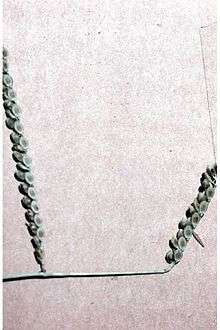Paspalum plicatulum
| Paspalum plicatulum | |
|---|---|
 | |
| Scientific classification | |
| Kingdom: | Plantae |
| (unranked): | Angiosperms |
| (unranked): | Monocots |
| (unranked): | Commelinids |
| Order: | Poales |
| Family: | Poaceae |
| Genus: | Paspalum |
| Species: | P. plicatulum |
| Binomial name | |
| Paspalum plicatulum Michx. | |
Paspalum plicatulum is a species of grass known by the common name brownseed paspalum. In Brazil its names include capim coquerinho, felpudo and pasto-negro. It is called zong zi que bai in Chinese and herbe à cheval in French. In South America its names include camalote, gamelotillo, and hierba de cepa.[1] It is native to the Americas, where it occurs in the southeastern United States, Mexico, the Caribbean, and parts of South America.[2][1]
This rhizomatous perennial grass has thick stems which can exceed 1 metre (3 ft) in height. The leaf blades are up to 35 centimetres (14 in) long. The inflorescence is a panicle with up to 7 branches. The paired spikelets are generally oval in shape and are brown in color.[2]
In its native range this grass grows in disturbed areas as well as prairies and forests.[2] It is planted in many areas of the world to feed livestock.[1]
The seeds provide food for birds.[3] It is used as a pasture grass and it can be made into hay. It can be grown on low-fertility soils. Cultivars include 'Bryan', 'Hartley', and 'Rodd's Bay'.[1]
References
- 1 2 3 4 Paspalum plicatulum. Tropical Forages.
- 1 2 3 Paspalum plicatulum. Grass Manual Treatment.
- ↑ Paspalum plicatulum. USDA NRCS Plant Fact Sheet.
